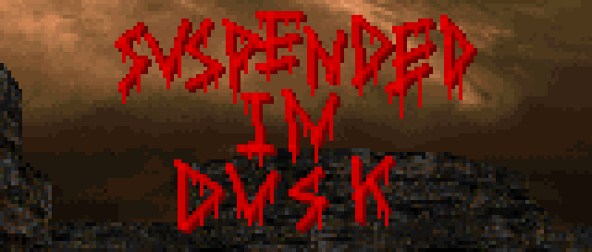
You can’t talk about Doom WADs without mentioning Suspended in Dusk. In the Doom scene, it’s a modern masterpiece, and if you ask a Doomer what their favorite WADs are, you’re almost guaranteed to find Suspended in Dusk on the list. It’s on mine for sure.
To cover some history, Suspended in Dusk was created back in 2005 by Esa “Espi” Repo, self-proclaimed “Finnish Doom freak.” Espi is best known for this and his followup, Back to Basics, but he also worked on some smaller WADs and contributed to a number of community projects and speedmapping sessions. So Espi was pretty prolific in the early and mid 2000s, and it seems just about everything he was involved with turned to gold. If he had kept at the craft, I can only imagine where he might have taken it. Unfortunately, the last release you’ll find with Espi’s name on it is his final speedmap, which was recovered and uploaded following his death in 2009.
Rather than dwell on what we’ve lost, though, let’s talk about what Espi gave us. From what I understand, Espi touched a lot of people, both as a Doomer and as a human being, and even if I never had the chance to meet him, I feel his influence too. Like every great work, Suspended in Dusk leaves an impression; it inspires, and maybe something of its creator lives on through it.
From all the praise it gets, you might expect Suspended in Dusk to be some grand, imposingly epic WAD — but it’s not. The entire thing spans only four maps, and it can be completed in a couple hours. It makes use of the standard cast of characters, a soundtrack taken from Doom, and mostly out-of-the-box resources (or edited versions of them). To top it all off, it runs on vanilla Doom; all the awesome that it achieves is managed within the confines of that old, hamstrung engine.
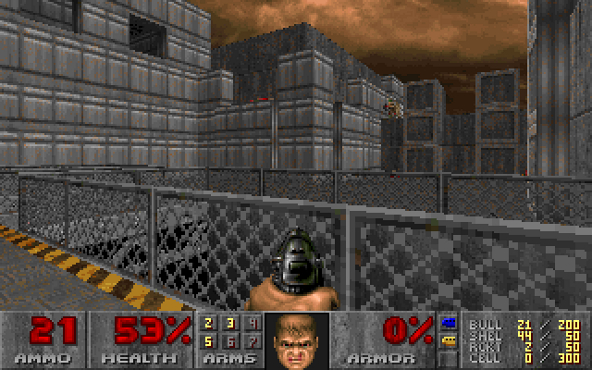
The term that first pops into my mind when I think of Suspended in Dusk is “connectivity.” Not a word you hear very often, probably; and use even less often. Connectivity isn’t a thing that’s generally on your mind when you play a game. I can guarantee you that you feel it, though. You feel it when a game has none — when you feel like you’re just following a narrow, linear path that the level designers have laid out in front of you. You feel it when a game does have a high level of connectivity, too — when there’s more than one way to get somewhere or complete some objective. When one area looks out over another that you haven’t reached yet and gets you excited to figure out how to get in there. When a level feels less like a level and more like a living place, and you’re exploring rather than being led. Suspended in Dusk is the latter. Very, very much the latter.
All the corridors and warehouses and computer labs that Suspended in Dusk strings together so masterfully wouldn’t be complete without monsters to mow down, and it has those in spades. Its levels are populated with all of the familiar faces, but the higher-tier enemies are used extremely conservatively. Most of what you’ll be up against are former humans, imps, and demons. The occasional baron or arch-vile, sprinkled lightly over four maps at just the right moments when the player might have been getting too comfortable, serve as a solid kick in the pants to remind you this ain’t no joke.
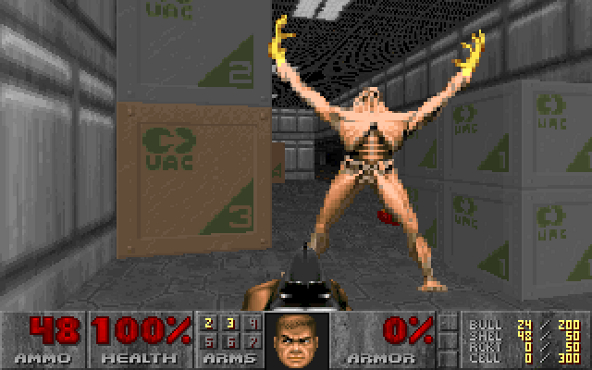
The WAD doesn’t pull its punches. It’s not frustratingly hard and it’s definitely not unfair, but when it feels like things have been too easy-going, it’s also not afraid to get your blood pumping. Suspended in Dusk keeps its cards close to its chest, though. It pits you against light resistance for most of the first two levels. Even when it throws a tougher enemy into the mix, it’s only one at a time. You don’t have time to get comfortable with the big, scary monsters, or to get used to blasting them in large numbers. Overall, the maps aren’t afraid you’ll get tired of fighting the lesser enemies; they don’t feel the need to constantly be ramping up the seriousness of encounters like some WADs fall into the trap of.
And yet, the difficult is ratcheted up. The third and fourth maps especially do not screw around, and when Suspended in Dusk gets serious, you know it’s serious. The first big teleport trap drops in the third level and you can really feel the weight of the situation because the WAD hasn’t been throwing these at you the whole time. Heck, there are hardly any teleport traps at all. Just carefully, cleverly placed monsters, right in the perfect position to mess up your day.
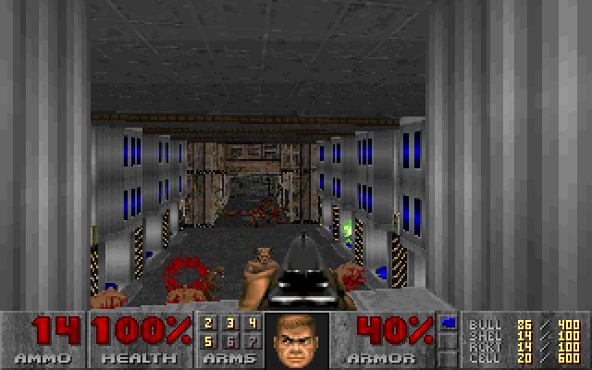
Just like the monster placement, the architecture of the WAD is subtly brilliant. Here, again, it’s all about quality rather than quantity. It’s not about the number of sectors or linedefs — extravagant detail — but about the effective use of as little as possible. Whether it’s the creative use of textures to create bottomless pits or hanging wires, crazy-economical sector use, or just how every single texture is custom-fit to avoid any tears or awkward seams, Suspended in Dusk is the perfect example of how you can still create something beautiful in an engine that’s twenty years old. “Less is more” and all that.
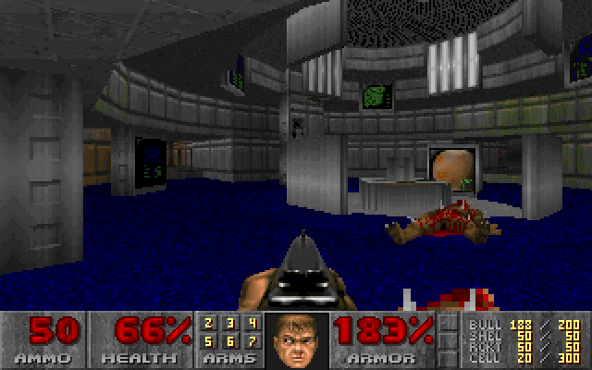
Simplicity. That’s what it’s all about in this WAD, but also in Doom editing in general. Too many designers, in my opinion, get carried away with special effects — mirrors and skyboxes and scripted events — and they forget that Doom has and always will work best when you keep it simple. Yet, for all its simplicity, Suspended in Dusk is full of single throwaway effects that other designers would probably think so clever that they’d shove them in at every opportunity.
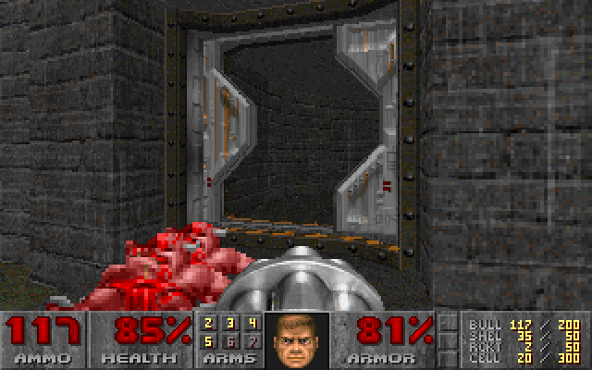
If you’re going to fault the WAD, the most solid ground you’ll find to do so from is regarding its color palette. Even if I was too engrossed on the first playthrough to notice, others have pointed out the color choice — or lack thereof — as a major problem with the mod. They are absolutely right that the levels are almost overwhelmingly grey and brown, very nearly forgetting all about the bright shades of green, blue, and red that the Doom engine takes pride in. But rather than a flaw or an oversight, I would chalk this up as an artist choice. The blandness of the base accentuates its cold, futuristic dreariness, and because we spend so much time looking at those two colors, the occasional splash of green nukage, blue circuitry, or — most importantly — the pink or reddish color of a dangerous enemy sticks out that much more and demands we take notice.
Speaking of taking notice, I also have to give mention the WAD’s selection of music, which is designed to build atmosphere while being noticed as little as possible. Here, we see the restraint that characterizes Suspended in Dusk in those simple, downplayed midis — some of the most atmospheric and least intrusive pieces from the original Doom. Over the course of the WAD, the music does build toward a logical, climactic conclusion, but even then on that final level, it’s the relatively simplistic Demons on the Prey, that throbbing, march-like drumbeat, pushing you subtly onward toward the final battle, but never getting in the way — never upstaging the gameplay itself — like the loud, garish, techno-esque midis have in other great WADs.
The awe-inspiring part of all this whole package is in the ease with which it’s woven together. Suspended in Dusk is maddeningly simple. Maddening to me, at least, as a WAD creator myself. One who could never design something half as elegant, as fluid, as confident in its own effortless beauty, as this. When you’re playing it, you have to keep reminding yourself that everything you’re seeing can be run (or is running) on the vanilla Doom engine. No limit-removing or advanced features. No nonsense.
So, honestly, if you ever want to get into WAD design —
No, scratch that. If you ever want to get into level design, play Suspended in Dusk. Then play through it a couple more times. You’d be doing yourself a huge disservice not to.
Suspended in Dusk requires DOOM2.WAD and will run on vanilla Doom or on any source port under the sun. If you’re not sure how to get it running, this may help. And for more awesome WADs, be sure to check these out!